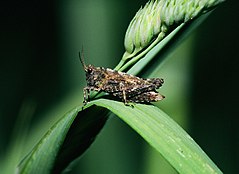Tetrigoidea
| Tetrigidae | |
|---|---|
 |
|
| Tetrix species | |
| Scientific classification | |
| Kingdom: | Animalia |
| Phylum: | Arthropoda |
| Class: | Insecta |
| Order: | Orthoptera |
| Suborder: | Caelifera |
| Superfamily: | Tetrigoidea |
| Family: | Tetrigidae |
| Subfamilies | |
Tetrigidae is a family in the order Orthoptera, which also includes similar families such as crickets, grasshoppers, and katydids (US) or bushcrickets (UK). Species within the Tetrigidae are variously called grouse locusts, pygmy locusts, groundhoppers or pygmy grasshoppers.
Pygmy locusts are less than 20 mm in length, and are recognizable by a long pronotum, that extends over the length of the abdomen, sometimes to the tip of the wings, and ends in a point. In other Orthoptera, the pronotum is short and covers neither the abdomen nor the wings. Tetrigidae are generally cryptic in coloration. Some species have enlarged pronota that mimic leaves, stones or twigs.
Roughly 1,600 species have been described in about 250 genera altogether.
In temperate regions, Tetrigidae are generally found along streams and ponds, where they feed on algae and diatoms. The North American species Paratettix aztecus and Paratettix mexicanus, for example, depend on aquatic primary production for between 80% and 100% of their diet. Riparian species are capable of swimming on the surface of the water, and readily leap into the water when alarmed Some species in the tribe Scelimenini are fully aquatic and capable of swimming underwater.
The highest biodiversity of Tetrigidae is found in tropical forests. Some tropical species are arboreal and live among mosses and lichens in tree buttresses or in the canopy, while others live on the forest floor.
...
Wikipedia
